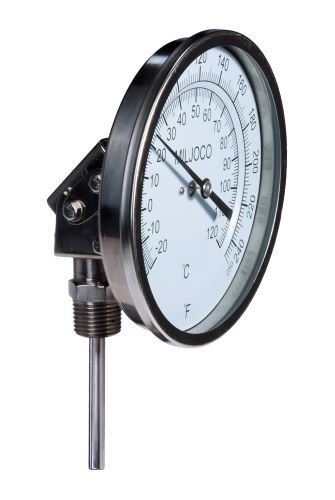Best Practices for Hydronic Systems Part 1: Tips for Selecting Thermometers
/Thermometers are required throughout a mechanical HVAC and plumbing systems--on boilers/water heaters and in ducts, condenser water piping, and chilled/hot water piping—to provide temperature verification and help with troubleshooting. In most of these applications, the standard liquid-in-glass thermometer is a suitable and economical option. But there are occasions when a different type of thermometer may be desirable. The most commonly used thermometers in commercial hydronic and plumbing systems are liquid-in-glass, solar-powered, and bimetal.
Liquid-in-Glass Thermometers
Liquid-in-Glass Thermometer
Liquid-in-glass thermometers far outnumber other types of thermometers in mechanical rooms. They are accurate, easy to read, and economically priced. They have an elongated metal casing and a glass or acrylic lens containing the temperature scale and a non-toxic, and tube with a non-toxic fluid that is colored for visibility.
Liquid-in-glass thermometers register temperature based on the expansion of the fluid within the tube. They are available with an adjustable angle fitting so that the thermometer can be angled up to 180 degrees for accurate reading if an eye-level reading is not possible in an upright installation. (Note that for the most accurate reading, the thermometer should be read at the same level as the liquid column.)
Bi-metal thermometer
Bi-Metal Dial Thermometers
Bi-metal dial thermometers have a stainless steel casing and flat face dial that can be adjusted to 90 degrees and a connection that can be rotated a full 360 degrees. This makes them a good choice for small spaces, awkwardly located installations, or installations where readings might need to be taken from many different angles or from a distance. They have an easier-to-read scale which is nice for the owner. The primary downside is cost—they tend to be about 50% more expensive than liquid-in-glass thermometers.
Bi-metal thermometers operate on the principle that different metals expand to different degrees. They contain two permanently bonded strips of metal that have different thermal expansion properties. This difference in expansion results in a certain degree of deformation when the temperature changes. This deformation results in rotary movement that is transmitted to the pointer of the thermometer.
Solar-powered thermometer
Solar Digital Thermometers
Solar-powered thermometers offer a large, easy-to-read LED display and fast read-out time. They are a good choice in areas with low light, although you may have to shine a flashlight on the display to activate the digital readout. Of course, if your mechanical room is dark (as many are) you will need a flashlight regardless of the thermometer type.
Solar thermometers have integral panels that collect light from multiple planes within the surrounding environment—no direct sunlight or bright indoor lights are required. An internal glass passivated thermistor measures electrical resistance. When the temperature changes, so does the resistance in the thermistor. This change is recorded by the solar-powered circuit and calibrated for the correct digital output.
Choosing the Right Scale
All of the above thermometers are available in various temperature ranges. Regardless of the type of thermometer you choose, keep in mind that the thermometer scale needs to match the range of the application. Liquid-in-glass thermometers are typically available in a wide range of temperature scales, so if you are choosing this type of thermometer you may likely require thermometers that have different scales depending on the application. When choosing a liquid-in-glass thermometer, we recommend using the following scales for the corresponding applications:
Application Recommended Temperature Scale
Chilled Water from 0°F to 120°F
Condenser Water 30°F to 180°F
Hot Water Heating 30°F to 240°F
The hot water heating scale is also suitable for domestic hot water and radiant heat, though smaller ranges would also work.
Include Insertion Wells
We also recommend installing insertion wells in the piping. These hollow metal tubes, typically made of brass, can be permanently installed in the pipe so that thermometers can be inserted into them to measure the temperature of the fluid. The well is closed off on the inserted end so the temperature probe never touches the contents of the pipe; the temperature of the fluid transfers through the well wall.
Insertion wells allow for temperature measurement without compromising the pipe and keep you from having to drain the entire system should the thermometer break and need to be replaced. The well can be provided with a lagging extension from the pipe so that the pipe can be insulated. A heat transfer paste can be packed into the well to provide maximum temperature response.





